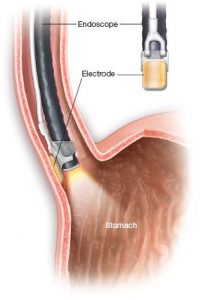What is the HALO Radiofrequency Ablation System for Barrett’s esophagus?
HALO ablation technology uses heat to eliminate diseased tissue known as Barrett’s esophagus. By targeting only Barrett’s tissue, this minimally invasive procedure leaves healthy tissue undamaged.
Why is the procedure necessary?
In patients with gastroesophageal reflux disease (GERD), stomach acid and enzymes can injure the esophageal lining. Over time, this damage can cause inflammation and genetic changes to esophageal cells, causing them to become intestinal tissue. This disorder is called “intestinal metaplasia” or Barrett’s esophagus. Patients who develop this disease have an increased risk for developing cancer of the esophagus. The HALO system removes the diseased esophageal tissue, allowing healthy tissue to grow in its place.
How does it work?
Using radiofrequency energy, or radio waves, the HALO system delivers heat energy through a catheter to eliminate diseased tissue. The HALO ablation procedure specifically targets only the layer of diseased tissue without harming the healthy structures underneath it.
How is it performed?
While a patient is under conscious sedation, a gastroenterologist will insert an endoscope, or a small fl exible tube, into the patient’s mouth. Depending on the extent of diseased tissue, the physician will choose one of two ablation catheters to attach to the end of the endoscope: a balloon-mounted catheter (HALO360) or an endoscope-mounted catheter (HALO90). The HALO360 catheter has a balloon at its tip that is covered by a band of radiofrequency electrodes and is used to treat larger areas of Barrett’s tissue. The gastroenterologist guides the endoscope so the electrode-covered balloon is on the treatment area, inflates the balloon and delivers a very short burst of controlled radiofrequency energy–for less than one second–to remove Barrett’s tissue. For smaller areas, the doctor will position the HALO90 catheter and its electrode on the diseased area of the esophagus to deliver the energy.
What are the risks?
The HALO radiofrequency ablation procedure is considered very safe. Patients may experience minor side effects, such as chest discomfort and difficulty swallowing for several days after the procedure. The physician will provide a patient with medication to manage these symptoms, which usually go away in three to four days.
As with any medical procedure, there are risks. Possible complications include mucosal laceration, infection, narrowing of the esophagus and minor acute bleeding. However, the overall complication rate for this procedure is very low.
What are the treatment benefits?
HALO ablation eliminates Barrett’s tissue in 98.4 percent of patients, allowing new, healthy esophageal tissue to grow in three to four weeks. Most patients recover quickly with minimal side effects, such as a sore throat. Because HALO ablation is a minimally invasive procedure, no incisions are required and it can be completed in an outpatient setting in around 30 minutes. In addition, the HALO system has a lower rate of complications than other forms of ablation therapy.

